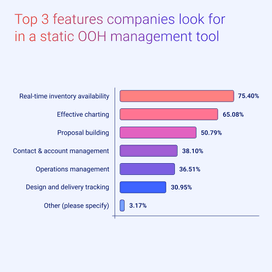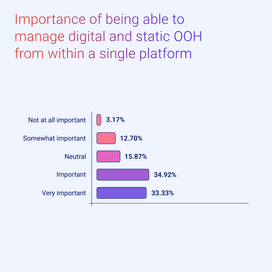While digital out-of-home (DOOH) has been a hot topic in the last few years, demand for static out-of-home (OOH) remains strong, representing about 70% of today’s OOH inventory. To better understand the industry’s dominant format, we conducted a survey to highlight the common challenges media owners face when managing static assets, where they see room for improvement, and how they see the medium evolving in the future.
Broadsign’s recently released State of Static OOH report summarizes the findings of the survey. We received data from more than 125 OOH professionals spanning over 60 companies spread across the globe. The majority of network types were hybrid, offering advertisers a mix of static and digital inventory, ranging from a few hundred screens to thousands. To celebrate its release, we highlighted a few key findings from the report.
Static OOH continues to thrive in a digital era
OOH networks with static inventory are actively integrating digitization into their core strategies. More than two-thirds of the static OOH media owners we surveyed operate “hybrid” networks, meaning they offer a mix of static and digital inventory to advertisers. That number is expected to grow, with nearly 43% of survey respondents saying they plan to invest in the digitization of existing static faces in the next one to two years.
While most media owners expressed a strong interest in modernizing and making their inventory more dynamic and data-driven, our data shows that static OOH isn’t going to be replaced anytime soon. In a digital-dominated era, static billboards provide advertisers a competitive edge thanks to their long-term exposure, eye-catching large formats, and strategic placements.
The enduring appeal of static media is also reflected in our survey results, which showed that 70% of OOH networks with inventory digitization plans intend to convert less than a quarter of their existing static faces. Additionally, 78% of respondents expecting these digitization efforts to not be completed for another two to five years.
Streamlining time-consuming static workflows will be crucial
Adopting more efficient static workflows is desirable and has become a strategic necessity for the continued growth of a static OOH media owner’s business. Today’s advertisers expect fast turnaround times, exciting new creative opportunities, and the ability to make last-minute changes. These demands pose a challenge for many media owners still relying on time-consuming manual processes and tools to manage their inventory.
In fact, 53% of the static OOH media owners we surveyed feel operational inefficiencies are putting them at a competitive disadvantage. To compete with other advertising channels, static media owners will need to confront the challenges posed by outdated inventory tracking systems and manual processes.
More advanced technology has arrived in static OOH
While there have historically been a number of perceived challenges around static OOH that have held back advertisers from investing in the medium, modern tracking methods and automated workflows are making those hurdles a thing of the past. Not only are these technological advancements delivering unparalleled efficiency, effectiveness, and value to every campaign, but they’re also increasing opportunities for both advertisers and media owners.
While technology priorities tend to vary from one static OOH business to another, almost all static media owners we surveyed agreed that their business would benefit from incorporating additional automation into their processes. Thankfully, this can be easily addressed by investing in a static OOH management platform that can automate the majority of tasks related to the proposal and posting process for static OOH campaigns.
We’re also seeing demand for real-time, all-in-one asset management solutions. Recognizing the importance of immediacy in today’s dynamic advertising landscape, static OOH companies are placing a premium on software solutions that provide real-time insights into their inventory availability. In fact, 75% of our survey respondents cite real-time inventory availability as one of the top features they look for in a static OOH management tool.
With the rise of hybrid networks that blend traditional and digitized inventory, the demand for solutions that can seamlessly handle both digital and static OOH is becoming more pronounced. Over 68% of static media networks surveyed recognized the importance of consolidating their management processes within a single, integrated platform.
Looking ahead, when asked which emerging technologies or trends they believe will be most important to the growth of the static OOH industry in the coming years, 59% of survey respondents cited data-driven targeting, and 47% cited data measurement and attribution.
The future of static OOH is a greener one
We’re seeing OOH media networks implementing more sustainable business practices and pledging to work towards a greener, more carbon-neutral future. With the majority of outdoor advertising networks facing increasing government restrictions around sustainability, almost 64% of the static OOH companies that we surveyed have already pledged to reduce their carbon footprint. An additional 17% expect to implement official sustainability measures for their business within the next few years.
Get the latest industry insights from our State of Static Out-of-Home report
Ready to take a deep dive into the world of static out-of-home advertising? Download your copy of The State of Static Out-of-Home Advertising Report.












